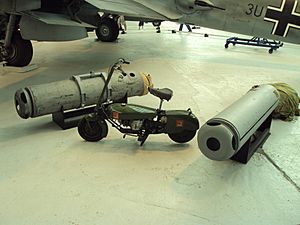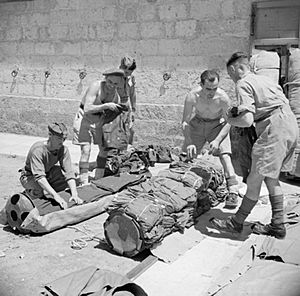CLE Canister facts for kids

The CLE Canister was a special container used by the British army during World War II. It was shaped like a big cylinder. Soldiers used these canisters to drop supplies from airplanes to their troops on the ground. The name "CLE" first came from the group that created it, the Central Landing Establishment. Later, people also said CLE stood for "Container Light Equipment".
Contents
How CLE Canisters Were Designed
At first, these canisters were made from wood and metal. An empty Mark I canister weighed about 46 kilograms (101 pounds). When full, it could weigh up to 159 kilograms (350 pounds). It was shaped like a cylinder, about 1.7 meters (5 feet 7 inches) long and 40 centimeters (16 inches) wide.
There was also a Mark 1T canister, which was made entirely of metal. It was a bit heavier when empty, weighing around 61 kilograms (134 pounds). However, it still carried the same amount of supplies, up to 159 kilograms. The Mark III canister was similar but slightly longer, at 1.8 meters (5 feet 11 inches).
Parachutes and Landing
One end of the canister held a parachute. This parachute opened automatically when the canister was dropped from the plane. A small pilot parachute opened first, which then pulled out the main parachute. The other end of the canister had a special pan-like shape. This part helped cushion the impact when the canister landed on the ground.
These canisters had a special hook system. This allowed them to be hung from the bomb racks of bomber airplanes. This made it easy for planes to carry and drop them.
Finding Canisters at Night
Sometimes, canisters were dropped at night. To make them easier to find in the dark, they could be fitted with four battery-powered lights. There were also tests to see if smoke markers could be used to help locate them.
What Was Carried in CLE Canisters?
CLE Canisters could hold many different kinds of supplies. They carried food, ammunition, weapons, or other important equipment. For example, a Mark I canister could hold 12 rifles and 1,000 rounds of ammunition. Special cylindrical fuel cans were also made to fit inside. One canister could carry three of these fuel cans.
Some items, like radios, were too delicate for CLE Canisters. They needed special, stronger containers to keep them safe during drops.
Identifying Supplies by Color
To make things easier, canisters were packed with specific items and given code numbers. If a unit needed supplies, they just had to ask for the code number and how many canisters they needed.
The type of supplies inside was shown by the color of the parachute. This way, people on the ground could quickly tell what was in each container without opening it. The colors were changed regularly to confuse the enemy. For example, during Operation Market Garden, red parachutes meant ammunition, green meant food, and white meant medical supplies. Blue was for fuel, and yellow was for communication equipment.
CLE canisters were also used to drop special equipment. This included a folding wheelbarrow called a "Para Barra" and even small folding motorcycles called Welbikes.
Beyond World War II
While mainly used in World War II, these canisters were also used later. They were part of Operation Musketeer in 1956. This was when British and French forces invaded the Suez Canal zone.
See also
- Lindholme Gear
- Storepedo



